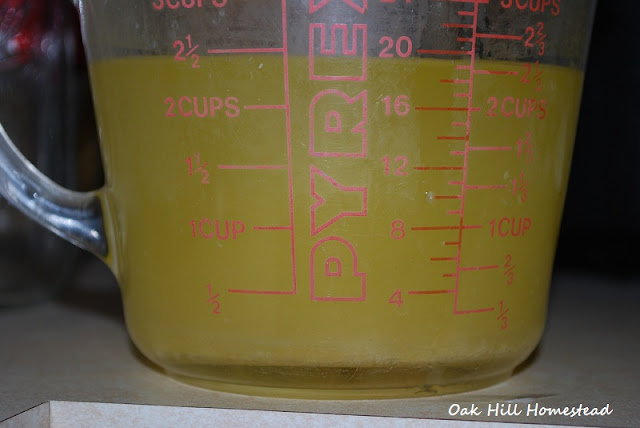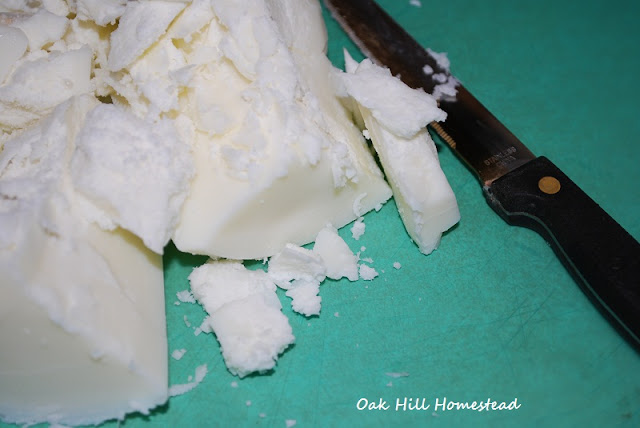How to render beef fat into tallow
When we took our steer to the butcher, I asked for the fat to be included in our order. Most folks don't ask for the fat from their animals, but we brought home four big bags of suet to be turned into tallow.
Four bags was more than I needed at the time, so I stuck the bags in the freezer and have processed them one by one as I needed tallow or had the time to deal with it.
Winter is an excellent time to render tallow: the heat of the stove (or the crockpot) on all day is quite welcome.
What is tallow?
Tallow is beef fat that has been rendered to remove bits of meat and other impurities. "Rendering" means to cook down the fat at a low temperature.
The crumbly fat from around the kidneys is known as suet.
Sheep fat is also called tallow, while the fat from hogs is known as lard. Lard is much softer than beef tallow.
Using tallow
I use tallow for cooking and to fry foods, especially french fries. Tallow contains a little less than 3% polyunsaturated fats, just a bit lower than coconut oil, and is much better for you than vegetable oils.
The other way I use tallow is in my handmade goat milk soap. Tallow is an excellent fat to use in soap making because it's easily absorbed by the skin and is very nourishing.
If you are going to purchase beef fat to render into tallow, be sure to look for grass-fed beef suet.
3 methods of rendering tallow
There are several methods to render tallow:
- in a slow-cooker or crock pot
- in the oven
- on the stove top
I like using the slow-cooker best, but I can't process as much tallow at a time in my large slow-cooker as I can in a stockpot. So, today I'm rendering this beef fat in a large stockpot on my stove.
Personally I don't like rendering fat in the oven because I worry about spilling it when removing the pot of hot fat from the oven. (Always think ahead when you work in the kitchen, whether you are canning or rendering fat or making soap. Be as safe as you can!)
Preparing the beef fat for rendering
Start by cutting the large pieces of fat into small pieces (cubes that are about one-inch in size) so they will cook more quickly. Suet is easier to cut with a sharp knife if it's just slightly frozen, so let it thaw a bit first.
Add the chopped beef fat to a large pot, then add enough water to cover it all. Bring it to a slow boil, then turn down the heat and let it simmer for several hours.
This is a slow process. Try to keep the temperature of the fat at about 130-140°F.
This is sometimes called "wet rendering" because we've added water to the fat. I think this method produces cleaner tallow than dry rendering, where no water is added.
How long does it take to render tallow?
It depends on a lot of things, such as how much fat you're rendering, how much water you put in the pot, the temperature of your stove and so on. It will take several hours.
Here's how you'll know when it's done, or at least close to being finished: the recognizable chunks of solid fat disappear and in its place will be golden yellow liquid fat.
It won't be completely liquid, there will be some solids in the pot, and the little bits of meat will begin to look crispy, but it won't look like the raw fat you started with.
The color of your liquid tallow fat may vary. Sometimes mine is a darker, deeper gold, and sometimes it's a lighter, translucent yellow.
The color just depends on a variety of factors that you aren't always in control of. The finished tallow though is usually a creamy white, no matter what color the liquid fat is.
Straining the finished tallow
When your tallow is finished, pour the contents of the pot through a strainer to remove the bits of meat and other solids. Pour the liquid into containers. I use my heavy glass mixing bowls that can withstand the heat of the hot oil.
Don't use plastic containers or bowls, they will melt!
Be careful while pouring the hot liquid fat from the pot into the bowls. The very-hot liquid can burn you much worse than boiling water can.
While some people pour the liquid right into canning jars for storage. I don't, because tallow becomes a pretty hard solid and it's hard to spoon it out of a jar. However, I'm including the directions for storing tallow in canning jars further down in this post, if you're interested.
Then put the the bowls of fat and water in the refrigerator overnight to cool. If it's winter, you can let them cool in an unheated mudroom, porch or garage instead, to save room in your refrigerator.
Even if your batch of fat was a deeper color when it was liquid, it will harden to a lovely white when the tallow cools and solidifies.
Leave the bowls undisturbed overnight to cool and harden. When the tallow has cooled, you'll see that the fat has risen to the top of the bowl and become hard, leaving the water underneath.
Separate the thick layer of solid white fat from the water on the bottom of the container by running a sharp knife around the edge of the container, then lift up the tallow in one piece - or several pieces if it so happens that way.
Be careful when you clean your pots and utensils. Fat poured down your drain can congeal and can stop up your plumbing.
If needed, give the underside of the layer of tallow a quick rinse with hot water to remove any debris.
This is why I prefer to render beef fat in water - so I can wash off the debris on the bottom of the layer of tallow. Without the water, the impurities are inside the solid layer of tallow and can't be easily washed off.
If this first rendering of tallow seems to smell of cooked meat (it happens sometimes), or if the underside of the tallow has more debris than you can clean off easily, you can do a second rendering to further purify the fat.
To do so, separate the solid fat from the water, add it back to the pot with some fresh water, melt the tallow and strain it again. It doesn't take long to redo it. Just heat it long enough to melt the fat and then let it harden again in the refrigerator.
Storing rendered tallow
To store your finished tallow, place the whole layer of solid fat in a freezer bag, label it, and store it in the freezer or refrigerator. Tallow will last nearly forever in the freezer.
You can also cut it into chunks and then place them in the zipper bag. This makes it easier to use a chunk or two at a time.
If you prefer to store your tallow in glass canning jars, heat it up again - without water this time - until it is melted, then pour the liquid tallow into canning jars, add lids and let it cool. Label and date each container so the oldest ones are used first.
You can store these jars in a cool, dark place such as a basement. I'm told that the jars of tallow can last up to a year.
For more self-sufficient and homestead-y posts like this, subscribe to my weekly-ish newsletter The Acorn, and join me on Facebook, Instagram and Pinterest. I'd love to see you there!
~~~~~
no matter your circumstances or where you live. Join me here:
Facebook | Pinterest | Instagram | Subscribe


















